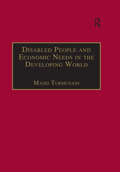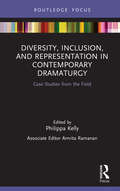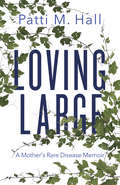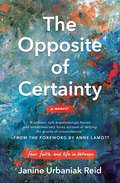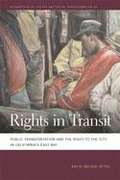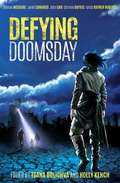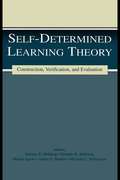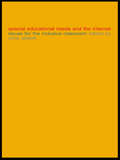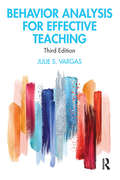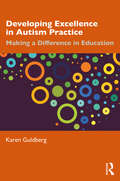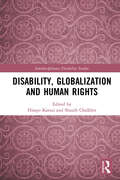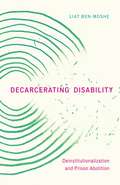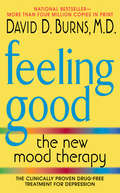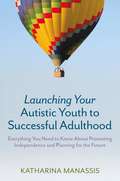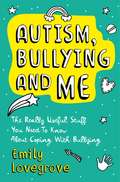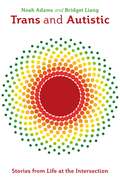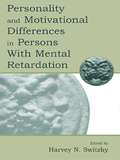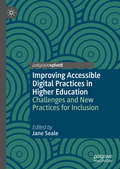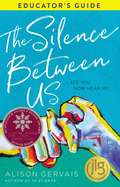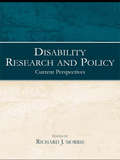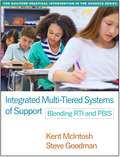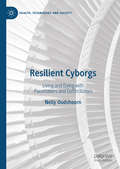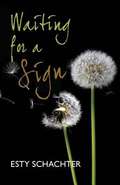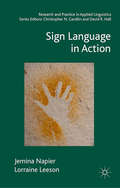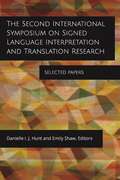- Table View
- List View
Disabled People and Economic Needs in the Developing World: A Political Perspective from Jordan
by Majid TurmusaniThis book explores the economic situation of disabled people in developing countries focusing on rehabilitation and uses particpatory framework to community development. Although dealing specifically with a case study from Jordan, this needs assessment study provides comparisons with other developing societies. The author considers the prospect for future improvement in disability policy at a time when state budgets are already over stretched by widespread poverty, unemployment and poor health conditions. The book is divided into three parts. Part one explores disability and economic rehabilitation within global context and sets the scene for understanding what disability is and the impact of having disability across cultures with emphasis on the experience of discrimination. Part two deals with disability theory and practice in Jordan in terms of economic policies and provisions available for disabled people. Part three presents concluding remarks on the rise of disability politics in developing countries and the development of a participatory policy agenda.
Diversity, Inclusion, and Representation in Contemporary Dramaturgy: Case Studies from the Field (Focus on Dramaturgy)
by Philippa Kelly Amrita RamananDiversity, Inclusion, and Representation in Contemporary Dramaturgy offers fresh perspectives on how dramaturgs can support a production beyond rigid disciplinary expectations about what information and ideas are useful and how they should be shared. The sixteen contributors to this volume offer personal windows into dramaturgy practice, encouraging theater practitioners, students, and general theater-lovers to imagine themselves as dramaturgs newly inspired by the encounters and enquiries that are the juice of contemporary theater. Each case study is written by a dramaturg whose body of work explores important issues of race, cultural equity, and culturally-specific practices within a wide range of conventions, venues, and communities. The contributors demonstrate the unique capacity of their craft to straddle the ravine between stage and stalls, intention and impact. By unpacking, in the most up-to-date ways, the central question of “Why this play, at this time, for this audience?,” this collection provides valuable insights and dramaturgy tools for scholars and students of Dramaturgy, Directing, and Theater Studies.
Loving Large: A Mother's Rare Disease Memoir
by Patti M. HallIf not me, then who will save my child? A mother must confront the unthinkable when her son is diagnosed with a rare medical condition. Patti M. Hall’s life is pitched into an abyss of uncertainty when a golf ball–sized tumour is discovered in her teenage son’s head and he is diagnosed with gigantism, a disease of both legend and stigma. After scrambling to access a handful of medical experts in the field, Patti learns that her son could grow uncontrollably, his mobility could be permanently limited, and his life could be cut short without timely and aggressive treatment. Patti’s attention shifts fully to her son, away from her relationships as well as her own career and health. Her new normal sees her step into a dozen additional roles, including nurse, researcher, advocate, risk assessor, and promise maker, while she struggles and fails to rebuild her life as a recently divorced woman. In Loving Large, Patti discovers that resilience is learned and that the changes experienced in the aftermath of crisis can often create the greatest opportunities.
The Opposite of Certainty: Fear, Faith, and Life in Between
by Janine Urbaniak Reid&“Brilliant, rich...breathtakingly honest and sometimes very funny.&” —Anne Lamott&“Extraordinary.&” —Caroline Leavitt&“Observant and warm...the finest company.&”—Kelly Corrigan&“A beautiful sucker punch, like life.&“—Ron Fournier&“Subtle, powerful, and hypnotic...&”— Martin Cruz Smith What happens when we can no longer pretend that the ground underfoot is bedrock and the sky above predictable?All Janine Urbaniak Reid ever wanted was for everyone she loved to be okay so she might relax and maybe be happy. Her life strategy was simple: do everything right. This included trying to be the perfect mother to her three kids so they would never experience the kind of pain she pretended not to feel growing up. What she didn&’t expect was the chaos of an out-of-control life that begins when her young son&’s hand begins to shake.The Opposite of Certainty is the story of Janine&’s reluctant journey beyond easy answers and platitudes. She searches for a source of strength bigger than her circumstances, only to have her circumstances become even thornier with her own crisis. Drawn deeply and against her will into herself, and into the eternal questions we all ask, she discovers hidden reserves of strength, humor, and a no-matter-what faith that looks nothing like she thought it would. Beautifully written and deeply hopeful, Janine shows us how we can come through impossible times transformed and yet more ourselves than we&’ve ever allowed ourselves to be.
Rights In Transit: Public Transportation And The Right To The City In California's East Bay
by Kafui Ablode Attoh Mathew Coleman Sapana DoshiIs public transportation a right? Should it be? For those reliant on public transit, the answer is invariably "yes" to both. Indeed, when city officials propose slashing service or raising fares, it is these riders who are often the first to appear at that officials' door demanding their "right" to more service. Rights in Transit starts from the presumption that such riders are justified. For those who lack other means of mobility, transit is a lifeline. It offers access to many of the entitlements we take as essential: food, employment, and democratic public life itself. While accepting transit as a right, this book also suggests that there remains a desperate need to think critically, both about what is meant by a right and about the types of rights at issue when public transportation is threatened. Drawing on a detailed case study of the various struggles that have come to define public transportation in California's East Bay, Rights in Transit offers a direct challenge to contemporary scholarship on transportation equity. Rather than focusing on civil rights alone, Rights in Transit argues for engaging the more radical notion of the right to the city.
Defying Doomsday
by Tsana Dolichva Holly KenchTeens form an all-girl band in the face of an impending comet. A woman faces giant spiders to collect silk and protect her family. New friends take their radio show on the road in search of plague survivors. A man seeks love in a fading world. How would you survive the apocalypse? Defying Doomsday is an anthology of apocalypse fiction featuring disabled and chronically ill protagonists, proving it’s not always the “fittest” who survive - it’s the most tenacious, stubborn, enduring and innovative characters who have the best chance of adapting when everything is lost. In stories of fear, hope and survival, this anthology gives new perspectives on the end of the world, from authors Corinne Duyvis, Janet Edwards, Seanan McGuire, Tansy Rayner Roberts, Stephanie Gunn, Elinor Caiman Sands, Rivqa Rafael, Bogi Takács, John Chu, Maree Kimberley, Octavia Cade, Lauren E Mitchell, Thoraiya Dyer, Samantha Rich, and K Evangelista.
Self-determined Learning Theory: Construction, Verification, and Evaluation (The LEA Series on Special Education and Disability)
by Dennis E. Mithaug Deirdre K. Mithaug Martin Agran James E. Martin Michael L. WehmeyerThis volume brings together four semi-autonomous bodies of research (choice, self-determination, self-regulation, and self-management) to form a new theory of self-engaged learning entitled, Self-Determined Learning Theory. This theory explains why and how students self-engage. It identifies the factors that give students the sense of control over their learning that is needed for sustained, adaptive, and ultimately successful learning. It begins by describing the characteristics of disengaged learners, then describes and illustrates self-determined learning theory within both normal and special populations. It then examines the theory's predictive value across several special population contexts and then concludes with a critique of the theory's credibility and worth. Divided into three sections--theory construction, theory verification, and theory evaluation--this volume is organized using the four steps of a previous book, Learning to Theorize: A Four Step Strategy. Step 1 defines a problem of not understanding something as discrepancy between what is known and not known about a circumstance. Step 2 searches for information and explanations to change the condition of not knowing into a condition of knowing. Step 3 evaluates the credibility and worth of the explanation constructed in Step 2. Step 4 adjusts existing beliefs so they are consistent with the new theory. Although aimed primarily at leaders in special education, it should also appeal to researchers and scholars in psychology, educational psychology, and school psychology who are interested in the applications of self-regulated learning theory--in this case to special populations.
Special Educational Needs and the Internet: Issues for the Inclusive Classroom
by Chris AbbottWith Internet access for every school now a reality, teachers are beginning to explore the use of the Internet in the education of children with special needs. This book describes its benefits for children across the spectrum of special educational needs, from those with physical disabilities or sensory impairment to those with learning or social difficulties.With contributions from leading practitioners in the field, this book addresses the huge range of possibilities the Internet and associated technology offer for these pupils. Combining current theory and debate with practical guidance and inspiring case studies, this book considers:* how the Internet can be used to gather and publish information* how to communicate effectively through technology* policy and management issues for schools* the continuing challenges for access and inclusion.This book will be of interest to all teachers involved in special education needs, in both mainstream and special schools.
Behavior Analysis for Effective Teaching
by Julie S. VargasBehavior Analysis for Effective Teaching is a clear, comprehensive book on the integration of non-aversive behavior analysis principles into classrooms and other school settings. Carefully revised and updated throughout, this third edition includes new content on precision teaching and a new chapter on how teachers can provide appropriate education for students with special disabilities who are included in their classrooms. Focused on merging behavior management with effective student instruction and illustrated with examples from real teachers’ experiences, the book is an ideal primary resource for undergraduate and graduate courses in teacher education, special education, school psychology, and school counseling, as well as for preparation toward the BACB Credentialing Exam.
Developing Excellence in Autism Practice: Making a Difference in Education
by Karen GuldbergThis ground-breaking book gives an accessible overview and synthesis of current knowledge of relevance to the development of excellence in autism education. By situating understandings of autism within a ‘bio-psycho-social-insider’ framework, the book offers fresh insights and new ways of thinking that bring together global pedagogic practice, research, policy, and the insider perspective. Guldberg critiques current notions of Evidence-Based Practice and suggests ways of bridging the research-practice gap. She explores the interrelationship between inclusive principles, distinctive group learning needs and the individual needs of the child or young person. Eight principles of good autism practice provide a helpful framework for how education settings and practitioners can adapt classroom environments and teaching so that autistic children and young people can thrive. Written for anyone who wants to make a difference to the lives of autistic pupils, Developing Excellence in Autism Practice provides practitioners and students on education courses with tools for best practices, and shows how to draw on these to implement true positive change in the classroom.
Disability, Globalization and Human Rights (Interdisciplinary Disability Studies)
by Hisayo KatsuiThe UN Convention on the Rights of Persons with Disabilities has facilitated the understanding that disability is both a human rights and development issue. In order to achieve the Sustainable Development Goals by 2030, the focus on disability inclusion has become increasingly important in the discourse of international and national efforts for "leaving no one behind", the motto of the SDGs. This book discusses pertinent and emerging themes such as disability rights, globalization, inequalities, international cooperation and representation. Evidence which has been obtained tends to show that persons with disabilities have been disproportionately left behind without proper representation, participation and inclusion. This book critically investigates the gaps at different levels, from top to bottom, and as importantly, within the global disability movement, for the realization of global disability rights, and theorizes the intersection of disability, globalization and human rights. Empirical case studies from different countries and contexts are introduced to deepen analysis on theories of critical disability studies from a global perspective. Co-edited by a disability researcher and the former United Nations Special Rapporteur on Disability, this book will be of interest to all students, academics, policy makers and practitioners working to advance the cause of disability rights around the world.
Decarcerating Disability: Deinstitutionalization and Prison Abolition
by Liat Ben-MosheThis vital addition to carceral, prison, and disability studies draws important new links between deinstitutionalization and decarceration Prison abolition and decarceration are increasingly debated, but it is often without taking into account the largest exodus of people from carceral facilities in the twentieth century: the closure of disability institutions and psychiatric hospitals. Decarcerating Disability provides a much-needed corrective, combining a genealogy of deinstitutionalization with critiques of the current prison system.Liat Ben-Moshe provides groundbreaking case studies that show how abolition is not an unattainable goal but rather a reality, and how it plays out in different arenas of incarceration—antipsychiatry, the field of intellectual disabilities, and the fight against the prison-industrial complex. Ben-Moshe discusses a range of topics, including why deinstitutionalization is often wrongly blamed for the rise in incarceration; who resists decarceration and deinstitutionalization, and the coalitions opposing such resistance; and how understanding deinstitutionalization as a form of residential integration makes visible intersections with racial desegregation. By connecting deinstitutionalization with prison abolition, Decarcerating Disability also illuminates some of the limitations of disability rights and inclusion discourses, as well as tactics such as litigation, in securing freedom. Decarcerating Disability&’s rich analysis of lived experience, history, and culture helps to chart a way out of a failing system of incarceration.
Feeling Good: The New Mood Therapy
by David BurnsRid yourself of anxiety, guilt, pessimism, procrastination, low self-esteem and other "black holes" of depression without drugs.
Launching Your Autistic Youth to Successful Adulthood: Everything You Need to Know About Promoting Independence and Planning for the Future
by Katharina ManassisThe transition from high school to adulthood is one of the most challenging times for young people on the autism spectrum. What will happen when all their familiar teachers, educational assistants and friends disappear after graduation? Who will replace them in the adult world? How will they manage this drastic change? Drawing on her experiences as the mother of a child on the autism spectrum and a child psychiatrist, Katharina Manassis shares common transition-related challenges and offers real solutions for each. The book helps parents and teens plan for every stage of the journey. The book includes discussion of what a successful transition means and how to set realistic goals. It explores specific aspects of the transition such as employment, independence and social life, and looks at how to address long-term concerns such as living arrangements and financial support.
Autism, Bullying and Me: The Really Useful Stuff You Need to Know About Coping Brilliantly with Bullying
by Emily LovegroveIt's not always easy to stand out from the crowd, especially if you're a teenager. There's a lot of information out there on how to deal with bullying, but a lot of it is contradictory or seems like it won't work...But this guidebook is different! Helping you sort fact from fiction, the book looks at the different forms bullying can take and debunks commonly held myths such as 'bullying makes you stronger' and 'ignore it and it will stop'. You'll learn techniques to clear your mind so that you can respond to bullying situations calmly and confidently and be positive about who you are. Finally, it's packed with self-empowering strategies for coping with being autistic in a neurotypical world, and practical tips so you can handle any bullying scenario.
Trans and Autistic: Stories from Life at the Intersection
by Noah Adams Bridget LiangThis ground-breaking book foregrounds the voices of autistic trans people as they speak candidly about how their autism and gender identity intersects and the impact this has on their life.Drawing upon a wealth of interviews with transgender people on the autism spectrum, the book explores experiences of coming out, with self-discovery, healthcare, family, work, religion and community support, to help dispel common misunderstandings around gender identity and autism, whilst allowing autistic trans people to see their own neurodiverse experiences reflected in these interviews.An incisive introduction clearly sets out up-to-date research and thinking, before each chapter draws together key findings from the interviews, along with advice and support for those providing support to autistic trans individuals. Both accessible and authoritative, Trans and Autistic is an essential publication for autistic trans people, their families, and professionals wanting to understand and support their clients better.
Personality and Motivational Differences in Persons With Mental Retardation (The LEA Series on Special Education and Disability)
by Harvey N. SwitzkyThis book presents the most comprehensive review of research regarding personality and motivational differences in persons with mental retardation. From the personal commentary of Edward Zigler, H. Carl Haywood, and Harvey N. Switzky, the book summarizes the classical work of the Yale and Peabody-Vanderbilt School over the last 40 years. A sampling of new directions in research is provided, including work on self-determination theory and practice; decision making; direct and indirect effects of genetic mental retardation syndromes on personality; personality and psychopathology in genetic mental retardation syndromes; a new theory of information processing linking cognition, motivation, and performance; and a sensitivity theory of motivation. This definitive work presents older and evolving newer models and applications to the field in order to demonstrate the power of motivational variables in understanding the behavior of persons with mental retardation. The purpose is to enhance the quality of life in persons with mental retardation and other developmental disabilities.
Improving Accessible Digital Practices in Higher Education: Challenges and New Practices for Inclusion
by Jane SealeThis book examines the role played by technologies in removing the disadvantage experienced by students with disabilities in higher education. Addressing five key themes, the editor and contributors explore the practices required of stakeholders within higher education institutions to mediate successful and supportive relationships between disabled learners and their technologies. Ultimately, the book argues that practice in the fields of disability, ICT and higher education is still not providing consistent and widespread positive learning experiences to students with disabilities. In order to address this situation, the field needs to creatively integrate knowledge gained through both research and practice, and to re-imagine what is needed for ICT to meaningfully contribute to a reduction in disadvantage for disabled students. This book will be of interest and value to scholars of disability studies, education and accessibility, and educational technologies.
Silence Between Us Educator's Guide
by Alison GervaisThe Silence Between Us Educator's Guide is a companion to The Silence Between Us by Alison Gervais. This guide can be utilized in the classroom, in a home school setting, or by parents seeking additional resources. Ideal for grades 7-12.
Disability Research and Policy: Current Perspectives
by Richard J. MorrisThis book is based on research and scholarship produced by the Meyerson Disability Research Project (MDRP) at the University of Arizona. Its chapters are divided into two major sections: 1) Disability Research Areas and 2) Disability Policy Areas. The first section addresses some relatively new areas of research and scholarship with adults and children, such as the use of technology (e.g., videoconferencing and computer technology) in service delivery, whereas the second section critically examines various public policy and legal areas that impact the daily lives of many persons having a disability.
Integrated Multi-Tiered Systems Of Support: Blending Rti And Pbis (The Guilford Practical Intervention In The Schools)
by Kent McIntosh Steve GoodmanMany schools have implemented academic response to intervention (RTI) and schoolwide positive behavioral interventions and supports (PBIS) as separate initiatives. This book provides keys to making these programs more effective, seamless, efficient, and sustainable by combining them into a single multi-tiered system of support (MTSS). Steps and strategies are outlined for integrating data structures, practices, teams, and district systems. Contributing authors present detailed case examples of successful MTSS implementation in three states. In a large-size format with lay-flat binding, the book features 27 reproducible checklists and evaluation tools. Purchasers get access to a companion website where they can download and print the reproducible materials plus other helpful resources. <p><p> This book is in The Guilford Practical Intervention in the Schools Series, edited by T. Chris Riley-Tillman.
Resilient Cyborgs: Living and Dying with Pacemakers and Defibrillators (Health, Technology and Society)
by Nelly OudshoornThis book examines how pacemakers and defibrillators participate in transforming life and death in high-tech societies. In both popular and medical accounts, these internal devices are often portrayed as almost magical technologies. Once implanted in bodies, they do not require any ‘user’ agency. In this unique and timely book, Nelly Oudshoorn argues that any discourse or policy assuming a passive role for people living with these implants silences the fact that keeping cyborg bodies alive involves their active engagement. Pacemakers and defibrillators not only act as potentially life-saving technologies, but simultaneously transform the fragility of bodies by introducing new vulnerabilities. Oudshoorn offers a fascinating examination of what it takes to become a resilient cyborg, and in the process develops a valuable new sociology of creating ‘resilient’ cyborgs.
Waiting For A Sign
by Esty SchachterShelly and Ian used to be close, but after Ian leaves home to attend the Hawthorne School for the Deaf, Shelly feels abandoned, and the two drift apart. <P><P> When Ian returns home with news that the future of Hawthorne is in jeopardy, Shelly isn't sure she wants him back. And Ian, who has enjoyed living with students and staff who sign all the time, feels angry when his family forgets to do the same. <P><P> An explosive argument that could drive brother and sister further apart actually offers hope for reconciliation-a hope that grows as Shelly's spirited best friend, Lisa, helps strengthen their bond. <P><P> The siblings grow closer still when they find themselves coping with an unexpected tragedy. To fully heal her relationship with Ian, however, Shelly needs to acknowledge and understand why Hawthorne-and access to the Deaf community-is so important to him. To do so, she'll need to take action and stop waiting for a sign. <P><P> Written by clinical social worker Esty Schachter, Waiting for a Sign celebrates the beauty and power of Deaf culture, offering readers an opportunity for insight and understanding.
Sign Language in Action (Research and Practice in Applied Linguistics)
by Jemina Napier Lorraine LeesonThis book defines the notion of applied sign linguistics by drawing on data from projects that have explored sign language in action in various domains. The book gives professionals working with sign languages, signed language teachers and students, research students and their supervisors, authoritative access to current ideas and practice.
The Second International Symposium on Signed Language Interpretation and Translation Research: Selected Papers (Gallaudet Studies In Interpret #18)
by Danielle I. J. Hunt Emily ShawThe Second International Symposium on Signed Language Interpretation and Translation Research was a rare opportunity for hearing and Deaf students, researchers, educators, and practitioners to come together and learn about current research in Interpretation and Translation Studies. These selected papers are comprised of research conducted in places such as Australia, Flanders, France, and Ghana, creating a volume that is international in scope. Editors Danielle I. J. Hunt and Emily Shaw have collected papers that represent the advances in the depth and diversity of knowledge in the field of signed language interpretation and translation research. Chapter topics include the use of haptic signals when interpreting for Deafblind people, the role of French Deaf translators during the 2015 Paris terror attacks, and Deaf employees’ perspectives on interpreting in the workplace. Signed chapter summaries will be available on the Gallaudet University Press YouTube channel upon publication.
